Fortnite Ballistic Competitive Guide: Expert Tips & Winning Strategies
Updated On: November 12, 2025 by Aaron Connolly
Essential Fortnite Ballistic Overview
Fortnite Ballistic shakes up Epic Games’ battle royale by turning it into a tactical 5v5 first-person shooter. Instead of a free-for-all, you play round-based matches where teams alternate between attacking and defending the Rift Point Device.
Core Rules and Game Structure
Ballistic uses a best-of-13 rounds setup. The first team to win seven rounds takes the match.
Each round is capped at 100 seconds, so things move fast. Teams swap sides after six rounds, so everyone gets a shot at attacking and defending.
The match ends as soon as one team hits seven round wins.
Round Structure:
- 30-second buy phase for weapons and gadgets
- 100-second action phase for the objective
- 7-second post-round before the next round
Players earn credits based on how well they perform. You spend these credits on weapons and equipment at the start of each round. If you play better, you get more credits and can buy better gear.
You only get one life per round. If you get taken out, you have to wait until the next round. Every move counts, so you feel the pressure.
Attackers and Defenders Roles
Attackers need to plant the Spike device at the Rift Point Device within the time limit. Once they get it down, they have to hold off defenders until it detonates or until they wipe out the enemy team.
Attackers get a few more credits to buy equipment, which helps them push against defenders who start closer to the objective. If you’re attacking, you really need to coordinate your pushes.
Defenders hang back and guard the Rift Point Device, making sure the Spike doesn’t go off. They can win by stopping attackers or by defusing a planted Spike.
Defenders start closer to where the action happens, so they get a positional advantage. But they still have to balance aggression with smart positioning.
Both roles ask for different strategies. Attackers focus on taking ground together. Defenders rely on positioning and quick reactions.
Objective: The Rift Point Device
The Rift Point Device sits at the heart of every Ballistic map. It decides where teams fight and how rounds play out.
Attackers have to plant the Spike right at the Rift Point Device. Planting takes four seconds, and you’re exposed the whole time. Teammates need to cover you while you plant.
Once planted, the Spike will blow after 45 seconds unless defenders defuse it. Defusing also takes four seconds, so those final moments get really tense. Everyone crowds around the device, trying to outplay each other.
Device Interaction Rules:
- Only attackers can plant the Spike
- Only defenders can defuse it
- Planting and defusing both take four seconds
- Any interruption cancels the action
Each map puts the Rift Point Device in a different spot, but it doesn’t move during the match. Teams have to tweak their plans based on where the device sits and what cover is nearby.
Getting Started in Early Access

Fortnite Ballistic dropped in early access on December 11, 2024. Players got their first real taste of Epic Games’ tactical 5v5 shooter.
Early access lets you jump into ranked and unranked matches while giving feedback that helps shape the game.
How to Access Ballistic Mode
Getting into Fortnite Ballistic is pretty easy once you know where to look. You’ll find the mode right in your Fortnite lobby, next to Battle Royale and Creative.
Step-by-step access:
- Launch Fortnite from the Epic Games Store
- Go to the main menu
- Click “Ballistic” in the game mode list
- Pick Ranked or Unranked
If you’re just starting out, unranked matches are the way to go. You don’t need any extra downloads or purchases—Ballistic comes with your normal Fortnite install.
Quick tip: Can’t see Ballistic? Try restarting your client. Sometimes Epic rolls out access in waves, especially when servers get busy.
Early Access Features and Limitations
Early access means you’re playing a version that’s still in progress. You get to try out cool new features, but you might run into some rough edges too.
Available features include:
- Full 5v5 tactical gameplay in first-person
- Ranked and unranked matchmaking
- Core weapons like Striker AR, Nemesis AR, Hammer Pump Shotgun
- Gadgets such as Recon Grenades, Frag Grenades, Proximity Mines
- A basic map rotation
Current limitations:
- Fewer maps than the final release will have
- Not as many weapon variants yet
- Matchmaking might take longer during busy hours
- Balance changes come in pretty often
Epic usually pushes out weekly patches during early access, so expect the game to change a lot.
Giving Feedback to Epic Games
Your feedback actually matters a lot during early access. Epic Games keeps an eye on several places for player suggestions.
Primary feedback channels:
- In-game reporting: Use the feedback button in Ballistic’s menu
- Official forums: Post on Epic’s Fortnite community forums
- Social media: Tag @FortniteGame and use #FortniteBallistic
Effective feedback includes:
- Specific weapon balance issues, with examples
- Map design feedback, ideally with screenshots
- Matchmaking problems, plus timestamps
- Gameplay ideas, with reasons why they’d help
We’ve noticed that Epic pays more attention to detailed feedback than to broad complaints. Try to focus on particular situations instead of just saying the game is “unbalanced.”
Core Competitive Mechanics
Ballistic runs on strict round-based rules. Every move you make can tip the match, especially with the economy system and the mid-match role swap.
Round System and No Respawns
Each round lasts exactly 1 minute and 45 seconds. Once you’re eliminated, that’s it until the next round.
The 25-second buy phase kicks off before every round. You buy weapons, shields, and grenades using credits you earned earlier. You can’t leave your spawn during this time.
When the round starts, the real pressure begins. No respawns—one bad move and you’re out, leaving your team to fight shorthanded. Every peek, every rotation feels risky.
Credits carry forward between rounds if you survive. If you get eliminated, you lose your gear and start the next round with basic credits. Careful play pays off; reckless plays can set you back.
If attackers plant the Rift Point Device, the timer pauses. This starts a 45-second countdown to detonation, and the round’s entire pace shifts.
Win Conditions and Role Swaps
Attackers win rounds by:
- Taking out all five defenders
- Planting and detonating the Rift Point Device (even if they get eliminated after planting)
Defenders win rounds by:
- Eliminating all attackers before the plant
- Defusing the device during the 45-second timer
- Running out the clock
After six rounds, attackers and defenders switch sides. Credits reset to 800, and you pick new Flex Gadgets. This mid-match swap forces you to show off both your attack and defense skills.
First team to seven round wins takes the match. If both teams hit six, you’ll play all 13 rounds.
Effective Teamwork and Communication
Your squad’s teamwork and comms can make or break you in Ballistic. Teams that talk and coordinate well usually outplay those who just run around solo.
Coordinating with Your Squad
Role assignments matter a lot. Before each round, figure out who’s entry fragging, who’s supporting, and who’s anchoring.
Your entry fragger should lead the charge with an SMG or AR. Support players follow up with gadgets like Bubble Shields or Frag Grenades. Anchors lock down back areas with long-range weapons.
Economy coordination keeps everyone geared up. If you have extra credits and a teammate is broke, drop them a weapon or buy them a shield. Sharing resources can keep your team strong.
Timing attacks is crucial. Don’t let defenders pick you off one at a time. Count down together—“3, 2, 1, go”—before you push a site or rotate.
During the buy phase, quickly plan your approach. Decide if you’re rushing a site or taking map control through Mid or Parking.
Flex Gadget synergy can swing rounds. Pair Recon Grenades with pushes, or drop a Bubble Shield to protect a teammate planting the device.
Callouts and In-Game Chat
Location callouts need to be fast and clear. Learn the names for key areas: A-Site, B-Site, Mid, Parking, Elbow, Storage, Drywall.
Use directional callouts like “two in Storage, one low” instead of vague stuff. If you know what gun they have, call it out: “Sniper Mid, don’t peek.”
Share economy info so teammates can buy smart. Say “I’m broke, need drop” or “Can buy for team” during the buy phase.
Utility callouts help your team use gadgets at the right time. Say “Bubble going down” or “Recon out” so everyone knows what’s about to happen.
If you get eliminated, give quick intel—enemy positions, health, rotations—then go quiet. Don’t keep talking and distracting your teammates.
Keep chat short during clutch moments. Don’t backseat the last player alive. Dead players should only give essential info.
Keep the vibe positive. Hype up good plays and don’t blame teammates for mistakes, especially since you’ll switch roles halfway through.
Mastering Flex Gadgets and Grenades
Picking the right flex gadget and using grenades well can totally change a match in Ballistic. Recon grenades give you key intel, and bubble shields can make or break site pushes.
Choosing the Right Flex Gadget
Each flex gadget has its own use. The Recon Grenade Kit is probably the most valuable for competitive play.
Throw a Recon Grenade into contested spots to spot enemies. It’s best used before you push a site or when you’re retaking. Aim for corners or choke points.
Proximity Mine Kit is awesome for defense. Drop mines on flanking routes or near the Rift Point to stop sneaky attackers. If you don’t use one, you can pick it back up and move it next round.
| Flex Gadget | Best Use | Cost | Damage |
|---|---|---|---|
| Recon Grenade | Intel gathering | Varies | 0 |
| Proximity Mine | Area denial | Varies | 50 |
| Frag Grenade | Clearing corners | Varies | High |
| Bubble Shield | Site holds | Varies | 0 |
| Impulse Grenade | Displacement | Varies | 0 |
The Frag Grenade Kit is great for forcing enemies out of cover. Try to time your throws so they go off as enemies peek or fall back. Most players find frags pretty straightforward compared to some of the newer gadgets.
Using Smoke Grenades and Bubbles
Bubble shields give you a short burst of cover that blocks bullets and grenades. Drop a bubble when planting at the Rift Point or holding tricky angles on defense.
Place your bubble between you and where enemies are likely to peek. The shield only lasts a bit, so make sure your team is ready to move when it drops. Use bubbles to block sightlines while teammates rotate or heal up.
Heads up: Enemies can walk right through bubbles, so don’t treat them like walls.
Try to stack bubble usage with other utility. Combine bubbles with recon grenades to make site takes safer. Place them near cover so you can duck out when the shield fades.
If you’re struggling with bubble timing, hop into aim trainers or casual games and practice. Deploy bubbles right before peeking or when you think a grenade is coming your way.
Loadouts, Weapons, and Consumables Strategy
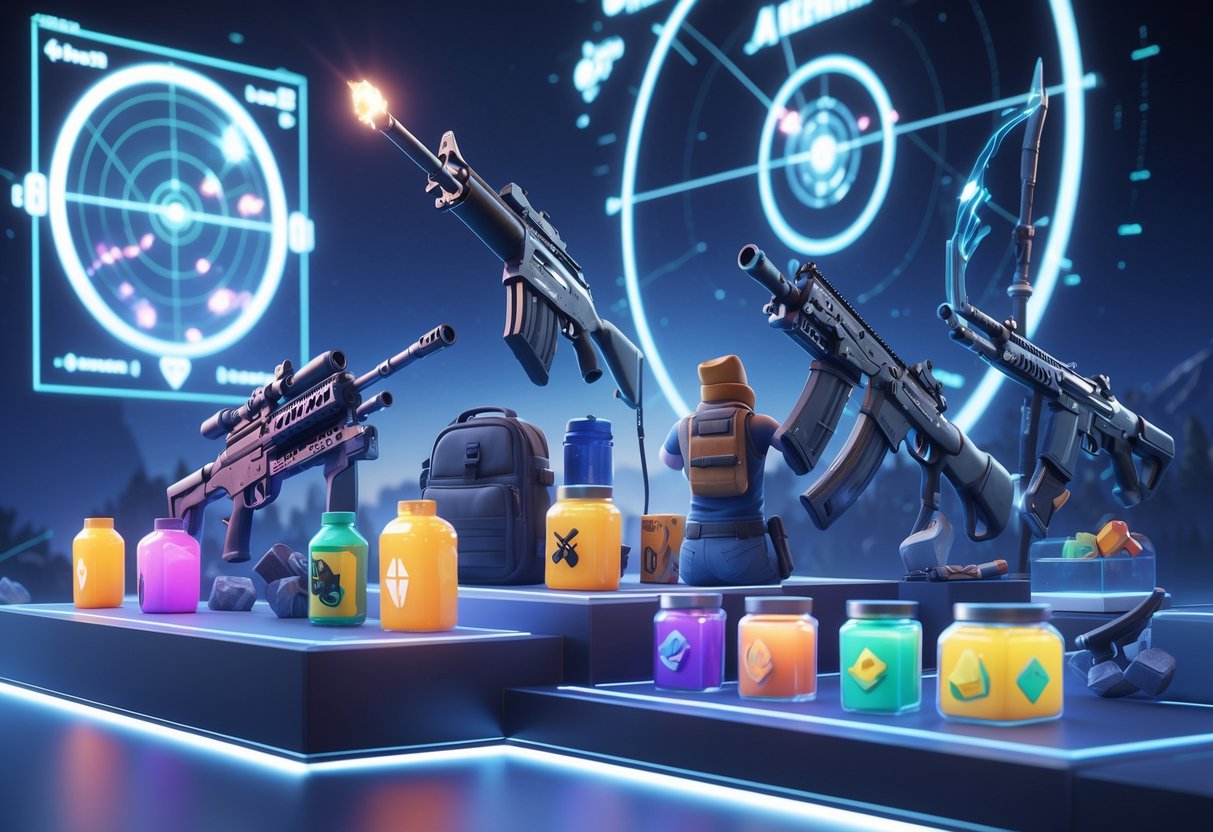
Managing your credits and picking the right weapons really sets the tone for Ballistic rounds. When you understand how each weapon works and pick your consumables wisely, you can swing even the closest rounds your way.
Weapon Types and Strengths
In Fortnite Ballistic, everyone starts with 800 credits and a Ranger Pistol. The way you spend those credits shapes your strategy from the first round.
Assault Rifles are the go-to for most players, honestly. The Striker AR sits at 2,500 credits, but its fast fire rate and decent mag size make it a reliable choice almost everywhere.
The Nemesis AR costs the same, but it fires a bit slower and hits harder per shot. Both rifles are great at medium range, so pick what feels better for you.
SMGs and Close-Range Options are perfect if you like to play up close. The Hyper SMG just went up to 1,800 credits (used to be 1,500), but its insane fire rate shreds at close range.
If you want a shotgun, the Frenzy Auto Shotgun is only 1,500 credits. Its auto-fire is brutal in tight corners—sometimes you just need to spray and pray.
Precision Weapons are for those who trust their aim. The Reaper Sniper Rifle is expensive at 4,700 credits, but it can one-shot an enemy, even through full shields.
The Enforcer AR gives you a cheaper precision option at 2,000 credits. It’s solid if you prefer landing careful, accurate shots instead of spraying.
Using the Ranger Pistol
The Ranger Pistol is what you get by default, but honestly, most players overlook how good it can be early on.
Try to save credits by actually learning the pistol’s rhythm. If you focus on headshots, the Ranger Pistol does pretty well at medium range.
With pistols, you really need to pay attention to positioning. Stick to cover and peek smart—missing shots hurts a lot more.
If you’ve got 800 credits, you might want to grab the Hand Cannon during pistol rounds. It’s a solid upgrade, hits hard, and rewards accuracy.
When you’re playing pistol rounds, work with your team. Push together to overwhelm defenders who are also stuck with basic weapons.
Teams that win pistol rounds usually get a big credit boost for the next few rounds.
Optimal Consumable Choices
Flashbangs are great for pushing into sites. They blind defenders, giving you a window to make a move.
Smoke grenades help both attackers and defenders. Block off sightlines when rotating or going for a plant.
Recon grenades let you spot enemies before you commit to a push or hold down a site.
Shield management is huge, especially if the enemy has something like the Reaper Sniper. Don’t skip shields if you know you’re up against heavy hitters.
Think about your team’s credit situation before buying consumables. Sometimes saving for a better weapon next round is smarter than loading up on gadgets now.
Try to balance your own play with what your team needs. A team with mixed utility usually outplays a squad with just expensive guns and no support items.
Earning and Managing Credits
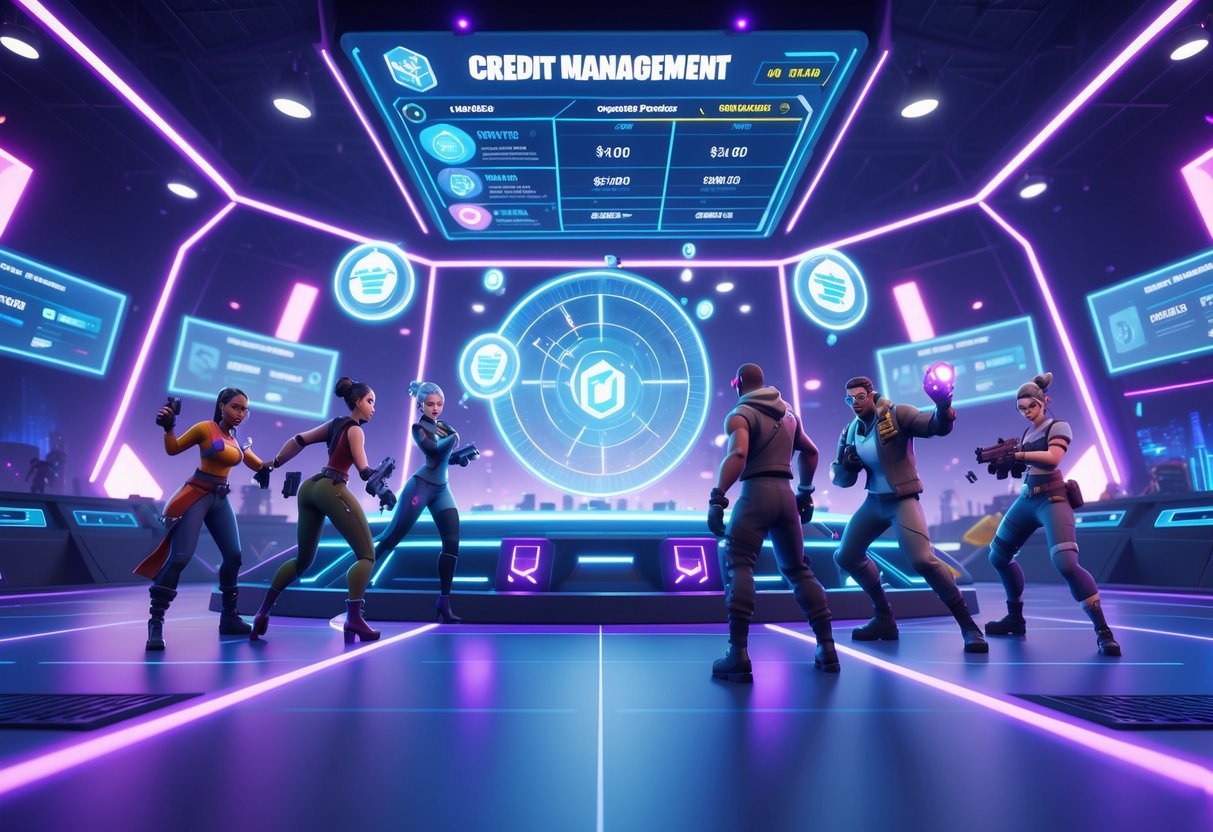
Credits fuel everything in Fortnite Ballistic. You start with 800 credits, but how you earn and spend them can totally change your game. Players who manage their credits well usually outpace those who just buy whatever’s flashy.
How to Earn Credits
Everyone begins with 800 credits, but if you want to build up your balance, you need to perform consistently. Winning a round gives you a hefty 3,100 credits—that’s the fastest way to stack up cash.
Even if you lose, you’ll still get some credits. Getting eliminated earns you 2,300 credits at first, and you get an extra 400 credits for each round you keep losing, up to 800 more before it resets.
Credit Earning Breakdown:
- Win a round: +3,100 credits
- Lose but survive: +1,000 credits
- Lose and get eliminated: +2,300 credits (goes up with each loss)
- Eliminate an enemy: +200 credits per kill
- Plant Rift Point Device: +200 credits
A lot of players forget that eliminations and planting the device always give you credits, even if you lose the round. Try to get at least one elimination and go for the plant whenever you can.
Credits reset to 800 when you switch sides, so don’t hang onto them too long before halftime.
Buying and Saving Tactics
If you really want to stand out in Ballistic, you need to manage credits smarter than the other team. Save up during early rounds—free utility items can get you through most situations.
Essential Free Items:
- Bubble Shield
- Frag Grenade
- Recon Grenade
- Overdrive
- Med-Mist Smoke Grenade
Save your credits for weapons that actually make a difference. Think about your team’s setup and the map before splurging.
If your team is low on credits, it’s usually better for one person to buy a helpful utility for everyone instead of everyone buying their own stuff.
Here’s a quick tip: buy utility first, then weapons. Free consumables are super valuable early on when everyone’s still using basic guns.
The buy phase starts each round, but honestly, you should plan your buys during the previous round so you’re not scrambling.
Mastering the Skyline 10 Map and Other Battlefields
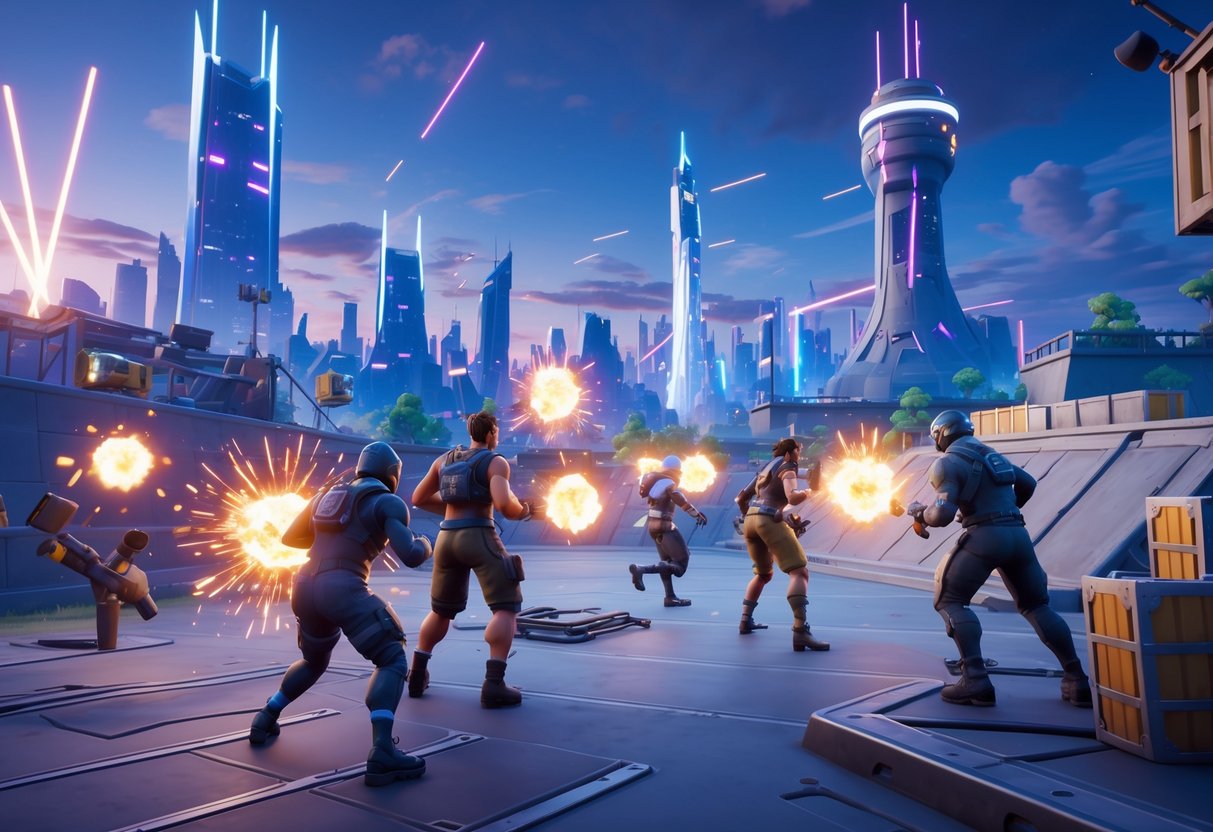
Skyline 10 is the only map in Fortnite Ballistic right now. Its tight urban rooftop design has two bomb sites and a mid area that connects everything. If you learn the three-lane layout and where defenders usually post up, you’ll have a big edge.
Key Map Layouts
Skyline 10 uses the classic three-lane setup: A-Site, B-Site, and Mid. The map feels like a Japanese city rooftop, with spots for close, mid, and long-range fights.
A-Site is reached through A Ramp—a narrow choke that’s tough to rush. Once you’re in, there’s cover behind containers, but you’ll need to clear out Lookout and Shops.
B-Site opens up via B Long, which is wider than A Ramp. It’s easier to push with teammates here. Defenders usually hold Parking and Drywall.
Mid control is everything. Mid connects to both sites through Corridor (to A) and Drywall (to B). If you control Mid, you can split attacks or cut off rotations.
Because the map is small, rotations happen fast. Defenders can switch sites in seconds, so attackers need to time things well.
Map-Specific Strategies
Pushing B-Site works best if you rush down B Long with utility. Smoke off Parking and Drywall, then drop a Shield Bubble to plant safely.
A-Site is trickier because of the narrow ramp. Try splitting through Mid first, then hit Corridor to A while your teammates keep pressure on B Long.
Defenders usually run a 2-1-2 setup (two per site, one Mid), but you can switch it up if the enemy keeps attacking the same spot. Sometimes a 1-2-2 works better.
Mid control really decides a lot of rounds. As attackers, always try to take Mid with smokes and flashes. Defenders can post a sniper in Mid to pick off attackers and watch rotations.
Flanking is possible because the map is so compact. If the enemy commits to one site, try sneaking behind them for a pinch. But don’t overdo it—good teams will catch on and leave someone watching the back.
Advanced Combat Techniques
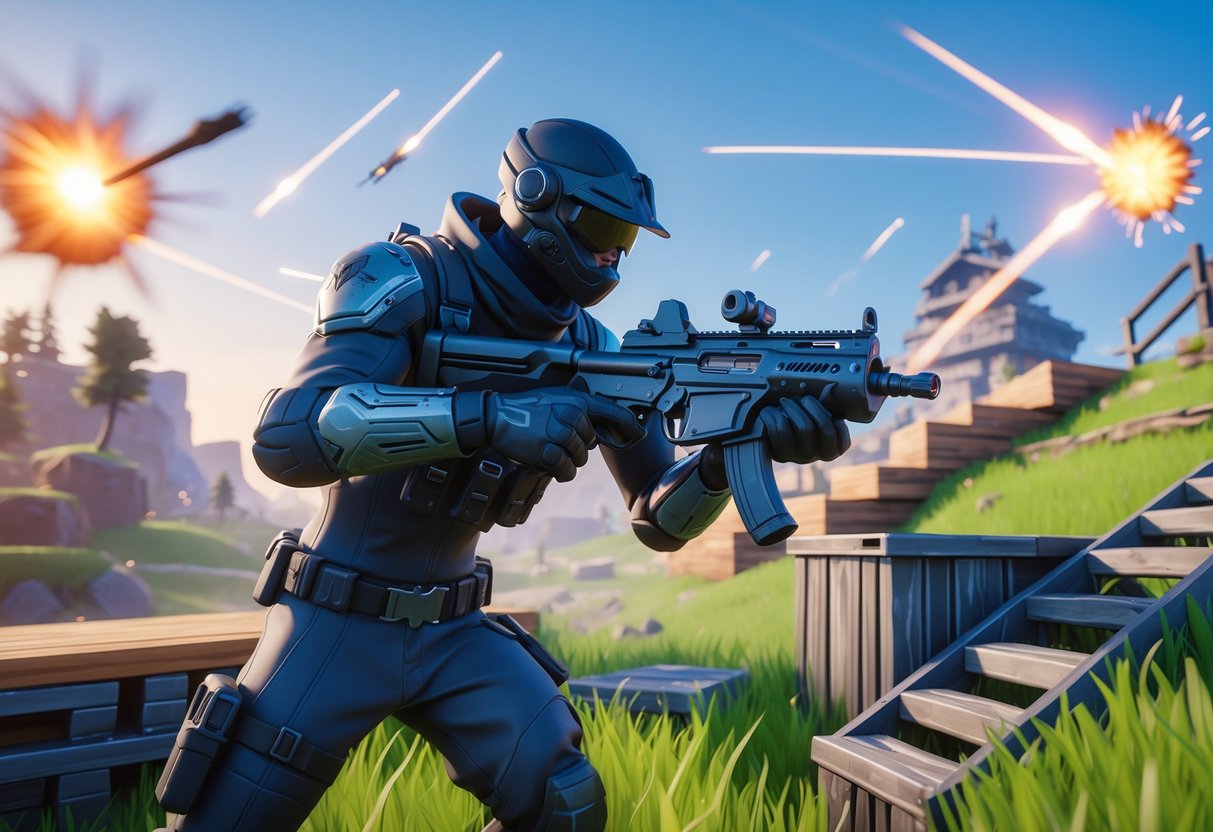
If you want to win ranked matches, you’ve got to nail the basics. Keeping your crosshair at head level makes those instant headshots way more likely, and using gadgets at the right time can flip a round.
Crosshair Placement and Recoil Control
Keep your crosshair at head height as you move. That way, you only need a small flick when someone peeks.
Always place your crosshair where you expect an enemy to show up. If you’re watching a doorway, line it up at head level right on the frame. When you rotate, keep that same height.
Recoil control is different for each weapon:
- Assault rifles: Pull down after the first few shots
- SMGs: Manage the initial kick, then watch for side-to-side movement
- Pistols: Pause between shots for better accuracy
Turn on “Show Recoil” in your settings. Your crosshair will show the recoil pattern, which helps you learn how each gun behaves.
Try to hit the firing range every day, even for just five minutes. Work on one weapon at a time until the spray pattern feels natural.
Burst fire at medium range instead of holding down the trigger. It keeps your shots tight and your damage up.
Gadget Timing and Usage
Gadgets can win rounds, but only if you use them at the right moment. Bad timing just wastes credits and gives the other team easy openings.
Plan ahead with your team. Decide who’s bringing which gadgets before the round starts. Usually, you’ll want: Smoke for site hits, Recon for info, and Flashbangs for opening up entries.
Throw smoke grenades a couple seconds before you push. That way, the smoke pops just as you move in, not too early or late. Use them to block off common angles, not just to hide.
Flashbangs need good timing. Cook them for a second or two before throwing so defenders can’t just look away. Always call out flashes so you don’t blind your own team.
Recon grenades should land on the site before you push. The info you get helps avoid ambushes and plan your attack.
Don’t hang onto gadgets forever. It’s better to use a Bubble Shield and survive than to die with it in your pocket. Buy gadgets early when credits are cheap—they get pricier as rounds go on.
Competitive Ranked Play Explained

Fortnite Ballistic uses the same eight-rank system as Battle Royale, from Bronze up to Unreal. But matchmaking works a bit differently—it goes by your party’s average rank, not just the highest player.
Ranked vs Unranked Differences
Ranked mode is all about competitive balance and progressing your skill. Your wins, losses, kills, and assists all affect your rank.
Here’s what the system tracks:
- Your current rank (this matters most)
- How many rounds you win or lose
- Your eliminations
- Assists
- Penalties if you leave matches
Unranked mode is just for fun—no pressure, no rank. It’s a great way to learn maps, try out new strats, or play with friends who aren’t on your level yet.
Ranked matches use skill-based matchmaking based on your party’s average, so games feel a lot more balanced.
If you’re new, start with unranked. You’ll pick up the basics faster without worrying about your rank.
Matchmaking and Penalties
You can queue with up to five players in ranked. Matchmaking uses your group’s average rank, not just whoever’s highest.
If you leave matches, you’ll get increasingly harsh bans:
- First time: 1 minute
- Second: 10 minutes
- Third: 30 minutes
- Fourth: 1 hour
- Fifth: 2 hours
- Sixth: 6 hours
- Seventh or more: 12 hours
If your game crashes or your internet drops, you can reconnect. You only get penalized if you don’t come back before the match ends.
Going AFK also costs you extra rank points, on top of whatever result your team gets. This keeps things fair and discourages people from bailing on games.
Playing as Attackers: Tactics and Tips
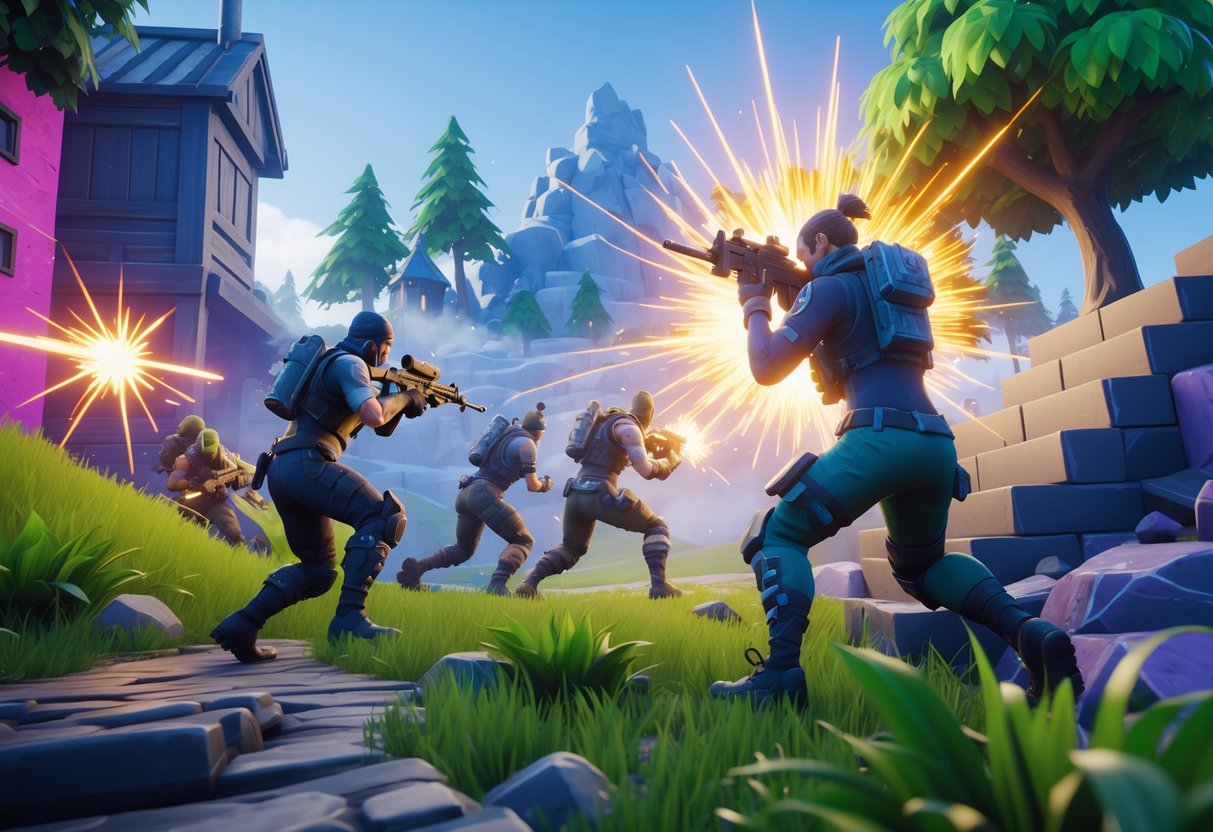
When you’re on attack, your main goal is to plant the Rift Point Device at either bomb site and take out defenders. Success depends on timing your pushes together and holding smart positions after the plant.
Effective Planting Strategies
Map control is the backbone of any good attack. Before you commit to a site, your team should gather info about where defenders are set up.
Send one or two players to scout the opposite bomb site first. This move usually forces defenders to show their positions and split their focus.
Execute fast site takes with at least three players. If you push slowly, defenders get more time to rotate and stack the site you’re hitting.
Use utility gadgets to clear out common angles as you enter bomb sites. Defenders love to sit in the same spots, round after round.
Trade kills right away when a teammate drops. If your entry fragger goes down, the next player needs to be ready to take out that defender instantly.
Plant for your team, not just for speed. Pick plant spots that actually help your surviving teammates defend the Rift Point Device from better angles.
Post-Plant Defence
Set up crossfires after planting the device. Defenders have to approach the bomb site, so you already know where they’re coming from.
Don’t all watch the same angle. Spread out and cover the different routes defenders might use to reach the Rift Point Device.
Play the clock, not just kills. You don’t need to wipe every defender—just delay them long enough so they can’t defuse in time.
Use sound cues to track where defenders are moving. Listen for footsteps and weapon swaps; they tell you when enemies are rotating or prepping for retakes.
Force defenders into tough spots by holding angles they have to cross. Make them fight for every inch to reach the planted device.
Save your best weapons and utility for late-round situations. Post-plant moments often decide the match, so keep your strongest gear for these clutch rounds.
Playing as Defenders: Strategies for Success
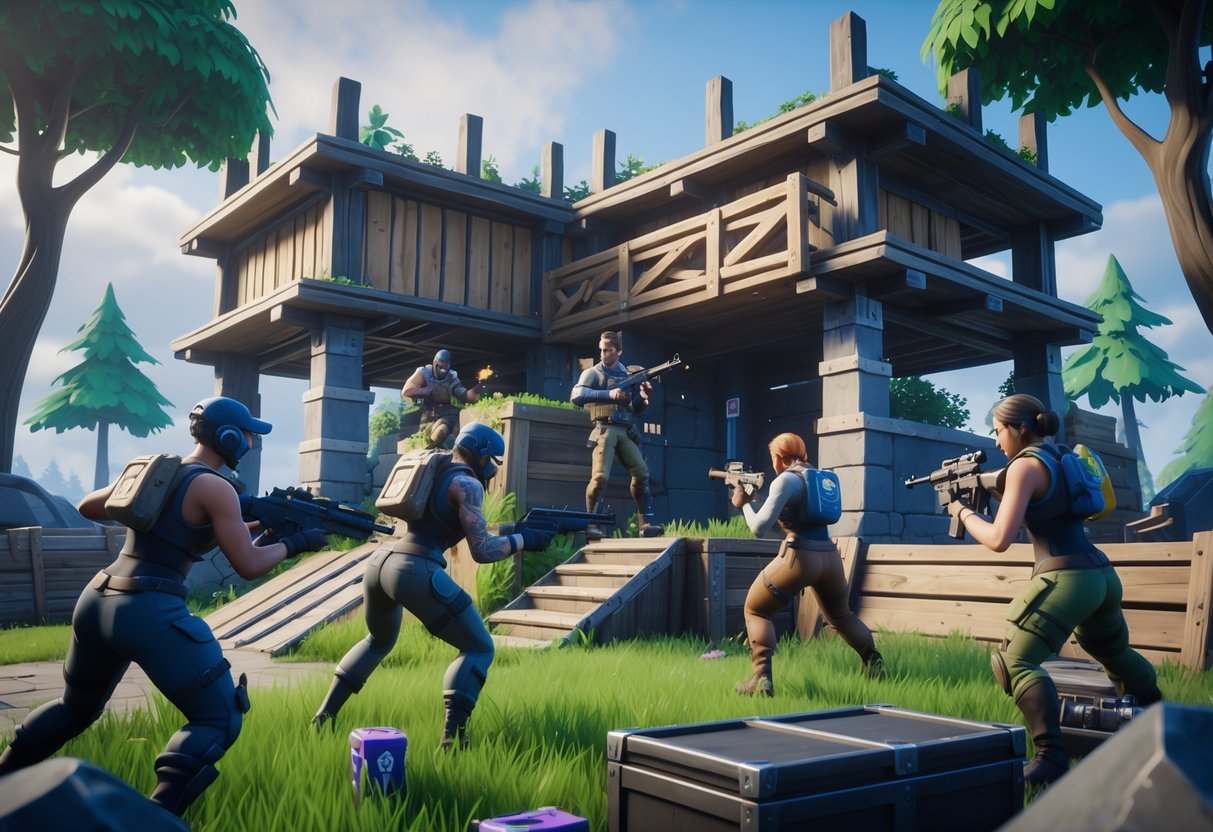
Defenders win by locking down key map areas and adapting to whatever gadgets attackers throw at us. We focus on holding strong positions while trying to counter those flexible tools that attackers love.
Site Control and Rotation
Map control wins defender rounds—we need to lock down spots that force attackers into predictable paths. The best move is to put one player in those weird mid-map corners attackers rarely check.
This corner camping trick works because attackers usually rush sites instead of clearing every possible angle. We just wait in those ignored spots until the push comes.
Rotation timing matters for keeping site control. We move around when we hear footsteps or see gadget usage in other parts of the map.
Quick rotations let us:
- Help teammates under pressure
- Flank attackers
- Retake lost map control
Sound discipline is key when we rotate. We walk instead of running to keep our new positions hidden. Attackers rely on those audio clues to track us, so why make it easy?
We keep our rotations clean by calling out when we’re moving. That way, teammates can cover the gaps.
Countering Flex Gadgets
Flex gadgets give attackers their biggest edge—these tools help them break in and open up sites. We try to predict the usual gadget combos and position ourselves to counter them.
Most attackers toss flex gadgets to clear corners or create distractions. We counter this by playing deeper angles where gadgets can’t reach or clear us out.
Watch for gadget patterns in the first few rounds. Attackers love to repeat what works, so we shift our spots based on what they’ve already used.
Key counter-strategies:
- Play off-angles that gadgets can’t pre-clear
- Bait gadget usage by faking our positions
- Reposition fast after gadgets go off
Teamwork makes our gadget counters stronger. If one defender sees a gadget get used, we call it out so everyone can adjust. That way, attackers can’t just use gadgets to break open the site.
Frequently Asked Questions

These questions cover the core skills you need to compete at higher levels. Let’s get into strategy development, mechanical improvements, aim training, resource management, mental preparation, and team coordination.
What are the top strategies for excelling in Fortnite competitive play?
Land at less contested spots near the centre of the map if you want late-game success. This gives you more options to rotate and keeps you away from early fights that can ruin your ranking.
Focus on making it to top 25 and top 10 rather than chasing high-kill games. Tournament scoring rewards survival, so play for placement over aggression.
Master zone rotations by learning where end zones usually pop up. Watch how pros rotate and try moving early instead of fighting the storm.
Could you share some tips for improving building and editing speed in Fortnite?
Spend 15-20 minutes in creative mode each day practicing basic builds. Use the Raider464 edit course or similar trainers to build up muscle memory.
Bind your building keys to buttons you can actually reach—lots of pros use side mouse buttons for walls and ramps.
Work on piece control tricks like cone placements and box fighting. These matter more in competitive matches than wild 90s.
Start with simple edits, like single tile windows, before jumping into fancy stuff. Speed will come once you get accurate.
What’s the best way to practise aim for Fortnite tournaments?
Kovaak’s FPS Aim Trainer has Fortnite-specific drills that fit the game’s sensitivity and mechanics. Try spending 30 minutes on tracking and flick shots.
Aim Lab’s Fortnite playlist gives you free aim training. Focus on shotgun flicks and AR tracking—skip the generic stuff.
Practice in Team Rumble mode for in-game aim. The nonstop action gives you real practice against moving targets, without the pressure of ranked.
If your aim feels shaky, lower your sensitivity. Most pros keep their sensitivities pretty low for more control.
How can one effectively manage resources during a competitive Fortnite match?
Prioritise materials: wood for quick builds, metal for late-game, brick for mid-game defence. Try to carry around 1,500 total mats before final zones.
Bring only the healing items you really need. Two shield items and two health items are usually enough, so you have space for shockwaves or launch pads.
Share mats with teammates in duos and squads. Let one player carry extra heals while others grab utility and ammo.
Don’t waste time over-farming early. Grab materials from eliminated players and break natural cover instead of spending forever harvesting.
What advice do you have for maintaining focus during high-pressure Fortnite gameplay?
Come up with pre-game routines that help you chill out. Breathing exercises or warm-up games can get you in the zone.
Set process goals instead of obsessing over placement. Think “secure this rotation” or “nail this edit” instead of “I have to win.”
Take a short break between tournament matches if you can. Even five minutes away from the screen helps you reset.
Put yourself in high-pressure situations during scrims or arena matches. The more you practice under stress, the easier it gets when it really counts.
Could you suggest some drills for enhancing teamwork in Fortnite duos and squads?
Try practicing coordinated building in creative mode. Focus on building connected structures, and let each player handle a specific job.
Come up with clear callout systems for spotting enemies or changing up your strategy. Stick to words and phrases that everyone on your team gets right away.
Jump into zone wars together as a squad. These custom matches really put your late-game teamwork to the test, almost like real tournament endgames.
Give everyone a role. Maybe one person leads rotations, someone else handles healing, and another goes in for those aggressive plays.

